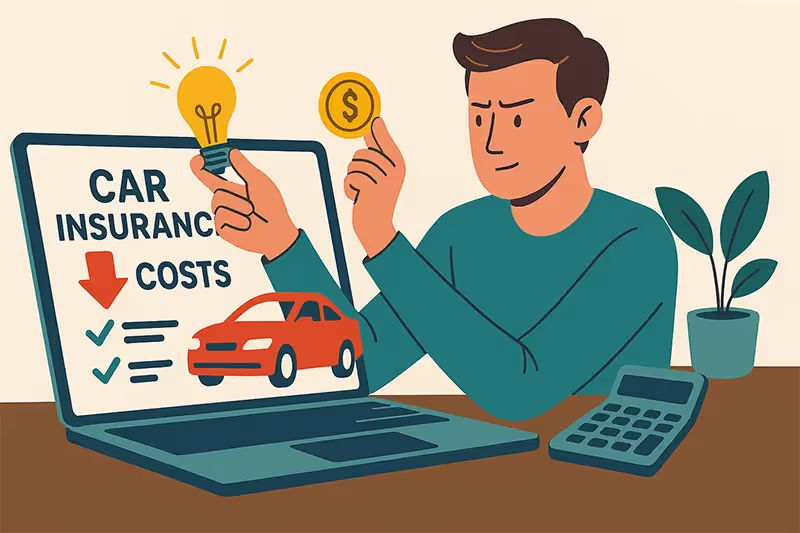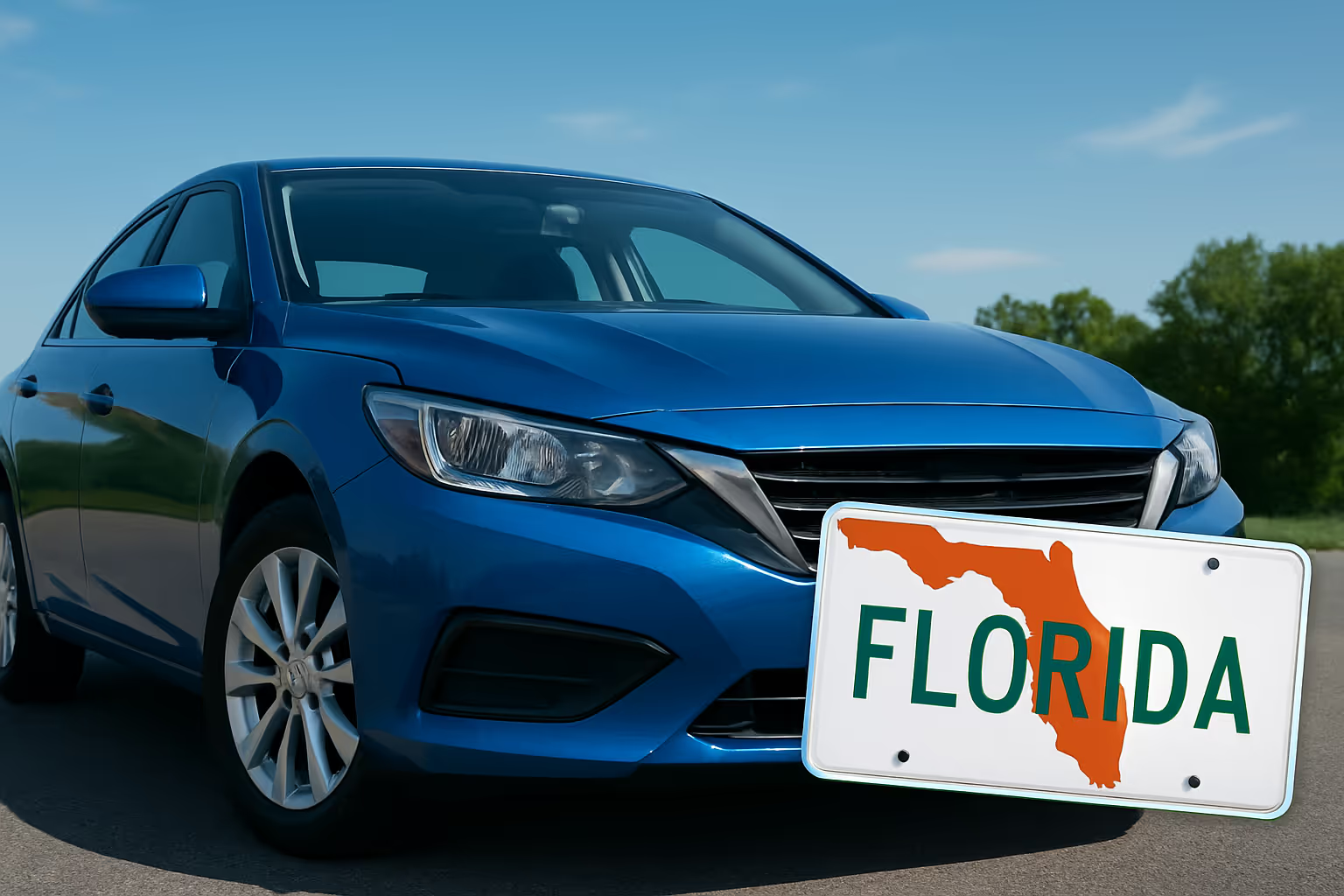How To Lower Your Car Insurance Premium (Without Slashing Your Coverage)

You can lower your car insurance premium without cutting coverage by reviewing your policy for outdated or duplicate features, improving your credit score, increasing your deductible if financially feasible, and asking about hidden discounts.
Other strategies include driving a lower-risk car, avoiding small claims, using telematics if you're a safe driver, and comparing rates every 6–12 months to stay competitive.
It’s tempting to just strip your policy down to the bare minimum when you’re looking to save. But cutting coverage can leave you exposed when it matters most. And probably stressed while driving, which kind of defeats the point.
Instead, here are realistic, actually-useful ways to pay less without giving up core protection.
Review what you’re paying for
Most people forget what’s even in their car insurance policy. It just renews every 6 or 12 months, and unless your rate jumps, you probably don’t touch it.
But that could mean you’re paying for coverage that doesn’t make sense anymore; or that you never really needed in the first place.
Here’s how to quickly spot some common money drains:
- Duplicate coverage: Already have roadside assistance through your credit card, dealership, or AAA? Then you probably don’t need it bundled into your car insurance too. Check your statements or benefits to be sure.
- Outdated mileage estimates: If you started working from home (or just drive a lot less than you used to) your policy might still reflect old driving habits. Updating your annual mileage can lower your premium. Insurers love low-mile drivers.
- Rental reimbursement you don’t use: This covers a rental car if yours is in the shop after a claim. But if you have a backup vehicle at home, or you could get by without a car for a few days, this might be an easy thing to cut.
- Coverage for a car you no longer drive much: Still carrying full coverage on that older second car that mostly sits in the garage? You might be able to reduce it to liability-only and save a few hundred dollars per year; depending on its value and how you use it.
Even doing a quick 10-minute review of your auto insurance policy could uncover $100–$300 in annual savings. And if you haven’t compared quotes lately, now’s a good time to check if your current rate is still competitive.
You can get a free quote here to see if there’s a better deal out there (with the same level of protection).
Improve your credit (yes, it matters)
This one surprises a lot of people: your credit score plays a major role in what you pay for car insurance. It’s not just about your driving history. In most states (including Florida) insurers use credit-based insurance scores to predict how likely you are to file a claim.
Better score = lower perceived risk = lower premium.
If your credit has improved recently, here’s what to do:
- Check your current credit tier: Most insurers group you into broad categories (poor, fair, good, excellent). Moving from “fair” to “good” could save you 10–20%, even if nothing else has changed.
- Ask your insurer to re-evaluate your rate: Paid off debt? Reduced your credit card balances? Fixed errors on your report? These all improve your credit standing. Contact your insurer and ask if they can re-run your credit score or re-rate your policy based on updated info.
- Shop around with your new score: Not every insurer weighs credit the same way. If yours isn’t offering a discount despite your improved score, get competing quotes. You may find another company gives you a much better rate for the same profile.
Some drivers save $200 to $500 a year just by improving their credit from one tier to the next. It’s one of the few long-term changes that keeps paying off.
Increase your deductible within reason
Your deductible is the amount you pay out of pocket before your insurance kicks in after a claim. And adjusting it can make a real difference in your monthly premium.
But, this only works if you’re financially ready to handle a higher upfront cost when something goes wrong.
Here’s how it usually breaks down:
- $500 deductible = higher monthly premium
- $1,000 deductible = lower monthly, but more risk if you file a claim
Some insurers may offer even higher options (like $1,500 or $2,000), but those only make sense if you’ve got solid emergency savings and rarely file claims.
Before changing yours, ask:
- Could you cover the higher amount today without dipping into debt?
- Do you drive often in high-risk conditions (commutes, urban areas, lots of traffic)?
- Have you filed claims in the past 3–5 years?
If you’re a low-risk driver with a good buffer in your savings, increasing your deductible could lower your premium by 10–20% or more. That adds up over a year.
Ask about hidden discounts
Not every discount shows up automatically when you buy a policy. In fact, many of the best savings require you to ask; or at least know they exist.
Here are some of the most commonly overlooked:
- Bundling with homeowners, renters, or even life insurance
Sticking with one company for multiple policies often leads to solid savings. - Good student discount
If there’s a student driver on your policy with a GPA of 3.0 or higher, this could shave 5–15% off. - Low mileage or remote work: If you drive less than 7,500 miles a year or work from home most days, that reduced risk can bring your rate down.
- Safe driver programs: A clean record over the past 3–5 years might qualify you for a loyalty or accident-free discount.
- Defensive driving course: In Florida and several other states, completing a state-approved course can lower your premium (especially if you're over 55).
Many of these aren’t offered unless you bring them up. So when you're talking to an agent or filling out an online quote, don’t hesitate to ask: “Are there any discounts I might be missing?”
It’s a simple question that could easily save you a few hundred dollars a year.
Drive a car that’s cheaper to insure
It’s easy to focus on the sticker price or fuel efficiency when car shopping. But insurance costs can vary a lot between vehicles, even if everything else looks similar.
Insurers look at how expensive a car is to repair, how often it’s stolen, and how it performs in crash tests. And some models quietly rack up higher premiums for reasons that aren’t obvious at first glance.
If you’re in the market for a car (or thinking of switching soon) keep these tips in mind:
- Avoid performance or sport trims: Turbo engines, sport packages, or upgraded suspensions may look fun, but they often come with higher repair costs and bigger premiums.
- Skip aftermarket modifications: Custom wheels, body kits, tinted windows, and other upgrades usually increase both the value and risk, which can raise your rate.
- Stick with practical, easy-to-repair models: Mid-size sedans, common SUVs, and popular brands with widely available parts tend to be the cheapest to insure.
- Check theft rankings: Some cars are more frequently stolen, even if they’re not new. A quick search for your model’s theft rate can help you avoid a surprise spike in your premium.
Before you buy, get an insurance quote on the specific car you’re considering. A simple change (like going from a sporty trim to a base model) could save you $300 or more per year.
Don’t file small claims
Here’s something most insurers won’t tell you upfront: even a minor claim( yes, even one that wasn’t your fault) can trigger a rate increase.
That’s because insurance companies look at claim frequency, not just severity. So if you file two small claims in two years, you might be flagged as a higher-risk customer than someone who filed none.
What counts as “small”? Usually repairs under $1,000 to $1,500. Think:
- Light bumper damage
- Scratches or dents from parking mishaps
- Minor vandalism with no suspects or video
In cases like these, paying out of pocket might cost less in the long run than dealing with a rate hike that sticks around for 3–5 years.
Before filing, ask yourself:
- Will the claim exceed my deductible by enough to make it worth it?
- Can I afford to cover this without draining savings or going into debt?
- Have I filed another claim in the last few years?
Remember: car insurance is really there to protect you from major financial hits: serious crashes, liability lawsuits, total losses. That’s where it earns its keep.
If you’re not sure how a small claim might impact your future rate, speak to your insurer first, or use a free quote comparison to see how your history affects current pricing. Being strategic with claims can make a big difference over time.
Use a telematics program (if you’re a safe driver)
Telematics programs (sometimes called usage-based insurance) track your driving habits through a mobile app or plug-in device. They collect real-time data on things like:
- How hard you brake
- How fast you accelerate
- What times of day you drive
- How often (and how far) you drive
If you’re a consistent, cautious driver, these programs can reward you with meaningful discounts; often between 10% and 30% after a few months of tracking.
Here’s when it might make sense:
- You drive mostly during the day: Driving at night, especially after 11 PM, is considered higher risk. Daytime drivers generally see better scores.
- You rarely speed or brake hard: Smooth driving habits signal lower risk to insurers.
- You don’t mind some privacy trade-offs: The tracking is opt-in, but it's constant while enrolled. If that makes you uncomfortable, it might not be a fit.
Some programs also offer an upfront discount just for participating, then adjust your rate later based on performance.
It’s not ideal for everyone. If your routine includes late-night driving, aggressive commutes, or unpredictable stops and starts, you might see little benefit; or even a rate increase.
But if your driving habits are already on the safer side, it’s an easy way to prove it and potentially lower your premium.
Re-shop your rate every 6–12 months
Insurance companies don’t reward loyalty the way you'd hope. In fact, some gradually increase rates over time, assuming you won’t bother to check.
So make it a habit:
- Set a calendar reminder every 6–12 months
- Get 2–3 quotes for the same level of coverage
- Use the info to either switch or negotiate
You don’t even have to switch every time. Sometimes just showing a competitor’s rate gets your current company to match or improve your deal. You can start the process right here in a few minutes.
Final thought (sort of)
You don’t need to gut your policy just to save money. In most cases, it’s about adjusting the details, staying proactive, and (frankly) being a bit annoying in asking questions and checking often.
The good news? Once you’ve done the legwork, you can usually coast for a while before revisiting it again. Unless something big changes in your life or driving habits.
And if you’re not sure where to begin, start with a fresh quote. See your options here.
Driving in Florida comes with a specific set of legal requirements and coverage options, from personal injury protection to uninsured motorist coverage. Whether you're new to the state or just reviewing your current policy, our guide to Florida car insurance will help you make an informed decision.
To see how Worth can reduce your risk.
Get a Free Quote


















